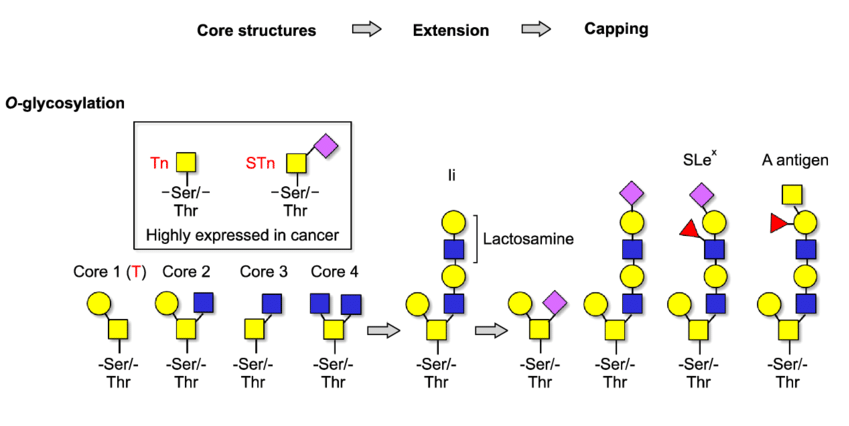Protein O-glycosylation Profiling Service
MtoZ Biolabs provides Protein O-glycosylation Profiling Service as an integrated solution that combines optimized glycoproteomics sample preparation, comprehensive O-glycan profiling, site occupation analysis, and detailed modification site characterization. By uniting these complementary approaches, our service delivers both global insights into O-glycan structures and precise site-specific information, enabling researchers to obtain a complete understanding of protein O-glycosylation.
Overview
Protein O-glycosylation is one of the most complex and biologically significant post-translational modifications in eukaryotic systems. It involves the covalent attachment of glycans to the hydroxyl groups of serine or threonine residues on proteins. Unlike N-linked glycosylation, which follows a conserved consensus sequence and relatively predictable biosynthetic pathway, O-glycosylation lacks a defined amino acid motif and is assembled in a stepwise fashion in the Golgi apparatus. This results in extraordinary heterogeneity in O-glycan structures, branching, and occupancy.
O-glycans play critical roles in maintaining epithelial barriers, regulating receptor activity, controlling immune responses, and mediating host–pathogen interactions. Dysregulation of O-glycosylation has been implicated in a variety of diseases, including cancer, cardiovascular disorders, autoimmune conditions, and neurodegenerative diseases. The detailed characterization of O-glycan modifications, glycan structures, and glycosylation sites has therefore become essential for both basic biomedical research and the development of biopharmaceuticals.

Kwon SW. et al. The Korean Journal of Blood Transfusion. 2015.
Figure 1. O-glycosylation on proteins.
Analysis Workflow
The general workflow of Protein O-glycosylation Profiling Service is as follows:
1. Sample Preparation
Proteins are extracted from biological samples such as serum, plasma, tissues, or purified glycoproteins, and contaminants are removed.
2. Protein Digestion
Samples are enzymatically digested into peptides while maintaining O-glycosylation sites for downstream analysis.
3. Glycan Release or Glycopeptide Enrichment
O-glycans are chemically released for global profiling, or intact glycopeptides are enriched to retain site-specific information.
4. Glycan Labeling and Separation
Released glycans may be labeled with fluorescent or isotopic tags for enhanced sensitivity. Chromatographic separation methods reduce sample complexity.
5. LC-MS/MS Analysis
High-resolution mass spectrometry characterizes O-glycan structures, quantifies abundance, and identifies glycosylation sites with high accuracy.
6. Data Processing and Bioinformatics
Advanced pipelines assign glycan structures, quantify modifications, and determine site occupancy, producing both global and site-specific results.
7. Report
Comprehensive reports include glycan profiles, structural characterization, site-specific maps, occupancy levels, quantitative comparisons, and scientific interpretation.
Service Advantages
1. Integrated One-Stop Solution
Covers the entire workflow from sample preparation to glycan profiling, site occupation analysis, and modification site characterization, ensuring comprehensive and seamless data acquisition.
2. Global and Site-Specific Insights
Provides both overall O-glycan composition and structure profiling as well as precise mapping of glycosylation sites and occupancy levels, giving a complete view of O-linked glycosylation.
3. Tailored Workflows for Diverse Applications
Optimized protocols support complex biological matrices, therapeutic proteins, and clinical samples, meeting the specific needs of biomedical and pharmaceutical research.
4. High-Data-Quality
Deep data coverage with strict data quality control. AI-powered bioinformatics platform integrates all Protein O-glycosylation profiling Service data, providing clients with a comprehensive data report.
Sample Submission Suggestions

It is recommended to contact our technical support team before submitting samples to determine sample suitability and obtain tailored submission guidelines.
Applications
Protein O-glycosylation profiling Service has broad applications in both research and industry:
1. Biopharmaceutical Development
Ensures consistent O-glycan structures and site occupancy in therapeutic proteins and antibodies, supporting product quality, efficacy, and regulatory submissions.
2. Cancer Research
Identifies aberrant O-glycan modifications and site-specific changes linked to tumor progression, metastasis, and immune evasion.
3. Immunology and Vaccine Design
Analyzes O-glycosylation of immune checkpoint proteins and viral glycoproteins to inform vaccine and immunotherapy development.
4. Host–Pathogen and Microbiome Studies
Investigates O-glycan modifications at the mucosal interface to understand interactions between host proteins and microbial pathogens.
5. Nutritional and Food Sciences
Characterizes O-glycans in dietary glycoproteins to study digestion, absorption, and functional health benefits.
Deliverables
1. Comprehensive Experimental Details
2. Materials, Instruments, and Methods
3. Total Ion Chromatogram & Quality Control Assessment (project-dependent)
4. Data Analysis, Preprocessing, and Estimation (project-dependent)
5. Bioinformatics Analysis
6. Raw Data Files







